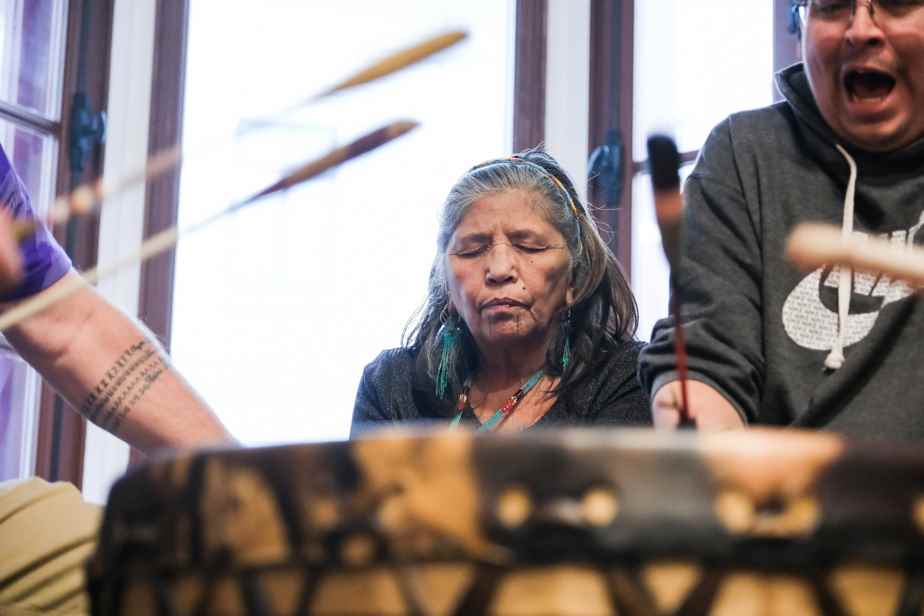Simeonie Tuckatuck, with shining eyes, observes the high ceilings of the new living room of the Maison Akhwà:tsire, inaugurated Monday, rue Saint-Hubert, in Montreal. Soon it will be his home. He can live there as long as he wants, after years on the streets.
For the first time in Montreal, a house that aims to permanently house homeless Aboriginal people has been created. While many such models exist for the general population, the Akhwà:tsire House (which means “my family” in the Mohawk language) was imagined and designed specifically to meet street Aboriginal people and offer them an option to long term.
The project was born in 2020, in the midst of a pandemic. “We realized that many people who came to the emergency shelters of Projets aboriginals du Québec (PAQ) had been doing so on a recurrent basis for years, sometimes more than 10 years,” said Heather Johnston, executive director of PAQ, during the ‘inauguration.

PHOTO CHARLES WILLIAM PELLETIER, SPECIAL COLLABORATION
Heather Johnston, Executive Director of Quebec Native Projects
For us, it made no sense. We needed to find a housing model for aboriginal people who had been homeless for a long time.
Heather Johnston, Executive Director of Quebec Native Projects
Nearly three years later, the ambitious project was born in a pretty Victorian house located in the city center of the metropolis, less than 500 meters from the CHUM.
-

PHOTO CHARLES WILLIAM PELLETIER, SPECIAL COLLABORATION
Interior of the Akhwà:tsire House
-

PHOTO CHARLES WILLIAM PELLETIER, SPECIAL COLLABORATION
Bedroom
-

PHOTO CHARLES WILLIAM PELLETIER, SPECIAL COLLABORATION
Shared bathroom
-

PHOTO CHARLES WILLIAM PELLETIER, SPECIAL COLLABORATION
Exterior view of the former Radio-Canada tower
1/4
A total of 22 people will be able to live there permanently, including couples, in 18 different rooms, six of which are accessible for people with reduced mobility. Common areas – living rooms, kitchens, bathrooms – will be shared by future residents.
PAQ psychosocial intervention services will be available 24 hours a day, seven days a week. Residents will be able to receive adapted physical health care (a nurse will work on site) and mental health care – including support. native elders.

PHOTO CHARLES WILLIAM PELLETIER, SPECIAL COLLABORATION
Marc Miller, Federal Minister of Crown-Indigenous Relations
“We need more places like this,” said The Press Marc Miller, federal Minister of Crown-Indigenous Relations, on the outskirts of the inauguration ceremony. “It takes an appropriate cultural connection. Sometimes institutional environments [pour itinérants] affect an Aboriginal person and a non-Aboriginal person differently. »
The six participants in PAQ’s Alcohol Management Program – including Mr. Tuckatuck – who previously lived in another house rented by the organization, will move to this new place as a priority.1.

PHOTO CHARLES WILLIAM PELLETIER, SPECIAL COLLABORATION
Designed by and for Indigenous people
In this house, the high ceilings, woodwork and plaster moldings give character to the rooms which are superimposed on three floors. “We came to visit it several times, remembers Mme Johnson. Each time, we said to ourselves that it was too good for us. And then, we wondered: why shouldn’t Aboriginal people have the right to a magnificent environment? »
The decorations were carefully chosen, on the theme of the seasons, in order to join the different nations in what they share, explained Julia Shuliau Hervieux, designer at the EVOQ architecture firm. She herself comes from the community of Pessamit, on the North Shore.

PHOTO CHARLES WILLIAM PELLETIER, SPECIAL COLLABORATION
Maison Akhwà:tsire is located on rue Saint-Hubert, in Montreal.
The project to acquire the building and renovate the premises was carried out at a cost of 6.8 million. In particular, the federal government contributed $4.7 million through the Canada Mortgage and Housing Corporation under the Rapid Housing Initiative.
Tenants will benefit from the Rent Supplement Program and will pay only 25% of their income to remain in place. The rest of the housing costs will be assumed by the Société d’habitation du Québec and the City of Montreal. Ultimately, all levels of government were involved in the project.
A prayer for the place
Proof of the importance of the cultural issue, the inauguration ceremony was led by Sedalia Fazio, elder of the Bear clan of Kahnawake, a Mohawk reserve located south of Montreal.

PHOTO CHARLES WILLIAM PELLETIER, SPECIAL COLLABORATION
Simeonie Tuckatuck (left) during her speech
The smell of medicinal sage permeated the premises during an initial prayer. Then, four musicians started chanting by playing the drum. In the room filled with dignitaries and people from the community, silence greeted the ceremony. Simeonie Tuckatuck’s eyes were wet with tears.
“I pray that Montrealers will recognize the Aboriginal people for what they are, and that we can move forward as one nation,” he said into the microphone a few minutes later, moved.
“I thank you all for being here, and thank you from the bottom of my heart for helping our world,” also said Sharon, from Mistassini, with a lump in her throat.
For Heather Johnston, “this is what reconciliation looks like”.
With The Canadian Press
Learn more
-
- 600
- Number of people supported by Native Projects of Quebec annually
SOURCE: Heather Johnston, executive director of the organization
- 250
- Number of accommodation sites for homeless people in Quebec
SOURCE: Lionel Carmant, Minister responsible for Services
social
